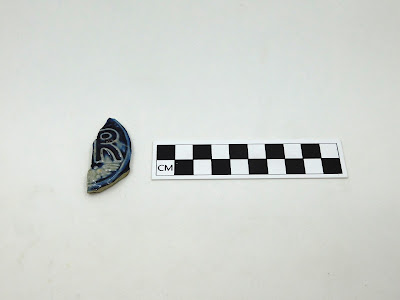Understanding Kannenbäckerland
The intricate detailing in Westerwald ceramics, also known as Kannenbäckerland, makes this artifact class of ceramic as recognizable as they are. Westerwald is a salt-glazed stoneware created from the clay deposits that developed about 30 million years ago, per the Keramikmuseum Westerwald. The usage of this clay for pottery purposes dates as far back as the Celtic clans around c. 750-450 BCE. Knowing the extensive history of this clay makes seeing the pottery firsthand that much more impressive. The sherds that I looked at were recovered from the 2019 excavation and the previous excavation between 1977-1983 at the c. 1695 Sherburne House.
While looking at the various sherds from both excavations, I noticed the difference in technique and precision in an "R" that I mended versus the other sherds I had seen. Even more interesting, when looking at a tankard on display in the Carter Center, we noticed the striking resemblance between the craftsmanship in the tankard, that was uncovered at Deer Street, and the "R" sherd from Sherburne House. The distance between the Deer Street dig site and the Sherburne dig site is approximately 0.5 miles. The proximity between both sites and similarity in shape and design suggests that there is a realistic chance these ceramics could have come from the same merchant.
This discovery makes us suspect that the singular "R" must belong to a similarly crafted George Rex tankard. Westerwald tankards with a "GR" medallion were produced between 1714 and 1820 during the reigns of King George I, II, and III. These wares were popular in the British and colonial markets. However, due to the artistry in these two pieces, it appears the ceramic is not Westerwald but instead from Staffordshire, England. In England, around the time of the popularity of Westerwald ceramics, the English took stylistic influence from Germany and tried the art style using their own resources. This replication process alongside England's own endeavors in stoneware ceramics is known as English scratch blue or debased stoneware.
As you can see from the two Westerwald tankards pictured below, the cobalt blue is intricately placed with little debasement from the site of origin. One can also note the similarities between Westerwald and English stoneware and the stark differences. Also pictured below is another ceramic from the Sherburne site, an example of Westerwald. The foliate carvings are sharp and maintain their colors.
Although this era of Westerwald was produced between 1600-1775, it was enough to inspire other ceramics. English stoneware was prominent between 1720-1775. The culture and significance behind Westerwald are kept alive by the community who flourished it. As included in "The Kannenbäckerland," the "Kannenbäcker Route" showcases to tourists the industry of Westerwald and the rich history behind it. To know that these sherds and vessels were once delicately crafted and transported 5781 km from the Lahan region of Germany to the grounds where I have walked these past two weeks is mind-shattering! Learning about the past is always fascinating, but being able to hold and see the past is even more fulfilling. In all this experience, I find myself understanding more of the meaning behind the word "Sankofa" from the people of Ghana. I hope we can continue to "go back and get it."






Comments
Post a Comment